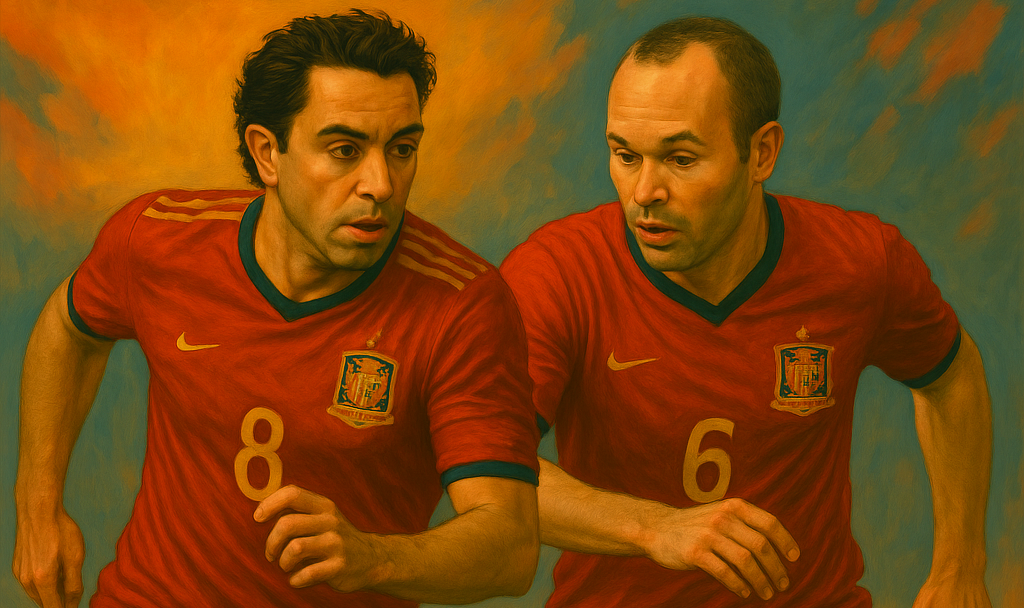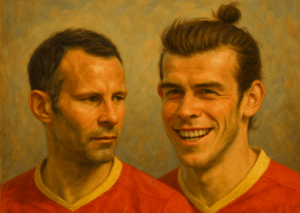
The GOAT of Barça’s Tiki-Taka Midfielder?
In the history of football, the names of certain players come to symbolize an era itself. Just as Pelé and Garrincha, Cruyff and Beckenbauer, and Maradona and Platini did, 21st-century football cannot be explained without two names: Xavi Hernández and Andrés Iniesta. They were more than just star players; they were the heart and brain of two of the most dominant teams in football history, FC Barcelona and the Spanish national team. The passes that began at their feet perfected a philosophy—’Tiki-Taka’—and changed the paradigm of world football.
This article is not intended to answer the question, ‘Who was greater, Xavi or Iniesta?’ Instead, it aims to deeply explore how two different forms of genius met to create the most perfect synergy in history, and what they left behind for modern football. Xavi was the architect of the system, while Iniesta was the artist who conjured unpredictable magic. Their story is a record of an era and a testament to the most beautiful heights the sport of football can reach.
1. A Symphony of Playing Styles: The Maestro vs. The Magician
Xavi and Iniesta shared the same philosophy, but the way their genius manifested on the pitch was distinctly different.
Xavi Hernández: The Master of the Game, The Lord of ‘La Pausa’
If one word defines Xavi, it is ‘Control.’ He was the conductor who dominated the time and space of the entire pitch. His greatest weapon was his brain, and the core technique that executed his brain’s commands was ‘La Pausa.’
- ‘La Pausa,’ meaning ‘The Pause,’ is the technique of intentionally holding the ball for a beat at the very moment an opponent applies pressure. In this brief moment of stillness, the defender is carried forward by inertia, and in that same instant, Xavi slips a pass into the vacated space. This was how he controlled the game.
- His other signature move, the 360-degree turn known as ‘La Pelopina,’ was more than just a technique to evade pressure; it was an act that bought time for the entire pitch to reorganize while he turned. He was not a player who played within the system; he was the Operating System that ran the system itself.
Andrés Iniesta: The Magician Who Broke Down Defenses, The Incarnation of ‘La Croqueta’
If Xavi was the maestro of order and control, Iniesta was the magician who created chaos within that order. His role was to break the deadlock in a stalled attack, and his magic spell was ‘La Croqueta.’
- ‘La Croqueta’ is a technique of quickly shifting the ball from one foot to the other in a tight space to dribble past a defender. The essence of this skill lies in drawing the defender towards him and then instantly neutralizing that defender to create a numerical advantage. If Xavi’s ‘La Pausa’ was a technique to ‘find’ space, Iniesta’s ‘La Croqueta’ was a technique to ‘create’ space.
- He not only elevated the system to perfection but was also the only one who could transcend it when it was neutralized.
2. Greatness in Numbers: Career Stats and Awards Comparison
Club and National Team Career Statistics
| Category | Xavi Hernández | Andrés Iniesta |
|---|---|---|
| Total Appearances | 1,135 | 999 |
| Total Goals | 129 | 104 |
| Total Assists | 239+ | 192+ |
| National Team | 133 caps, 13 goals | 131 caps, 14 goals |
Major Team Trophies
| Competition | Xavi Hernández | Andrés Iniesta |
|---|---|---|
| FIFA World Cup | 1 | 1 |
| UEFA European Championship | 2 | 2 |
| UEFA Champions League | 4 | 4 |
| La Liga | 8 | 9 |
| Copa del Rey | 3 | 6 |
| Total (Major Trophies) | 28 | 35 |
Major Individual Awards
| Award | Xavi Hernández | Andrés Iniesta |
|---|---|---|
| Ballon d’Or (Best Finish) | 3rd (2009, 2010, 2011) | 2nd (2010), 3rd (2012) |
| UEFA Best Player in Europe Award | 2nd (2011) | 1st (2012) |
| IFFHS World’s Best Playmaker | 4 times (2008-2011) | 2 times (2012, 2013) |
3. Tactical Roles and Partnership: The Engine of Tiki-Taka
The partnership between Xavi and Iniesta truly blossomed during the FC Barcelona era led by coach Pep Guardiola.
- Xavi: He operated from a deeper position, acting as the deep-lying playmaker, or ‘regista,’ who orchestrated the game. He was the hub through which every pass flowed, and the tempo of the game was decided at his feet.
- Iniesta: He played in a more advanced position, tasked with breaking down defensive lines on the foundation of stable possession that Xavi had built. His role was to provide decisive opportunities through dribbling and creative through-balls.
If Xavi was the team’s ‘spine,’ Iniesta was the ‘dagger’ that pierced the opponent’s heart. This perfect partnership was also the crucial background that gave rise to the greatest player of all time, Lionel Messi.
4. Moments of Greatness: Memorable and Decisive Scenes
Xavi: The Games He Dominated
Xavi’s greatness lay in his consistency, dominating matches for the full 90 minutes. A prime example is the Euro 2008 final. Against Germany, he completely controlled the midfield, dictating every aspect of the game and assisting Fernando Torres’s winning goal, which brought Spain its first major trophy in 44 years.
Iniesta: The Goals That Changed History
If Xavi was the master of the process, Iniesta was the creator of the result.
- The Miracle at Stamford Bridge (2009): In the Champions League semi-final second leg against Chelsea, with defeat looming, he scored a dramatic right-footed long-range shot in injury time to send his team to the final.
- The 2010 World Cup Final: In the 116th minute of extra time, he scored the winning goal, securing Spain’s first-ever World Cup title. This goal is the symbolic scene that completed the golden era of Spanish football.
Conclusion: The Legacy of Two Giants in Football History (2025)
Xavi as a Manager, Iniesta as an Icon
Xavi is continuing his role as the ‘brain’ in his managerial career, just as he did as a player. His coaching philosophy is a clear re-creation of the positional play and possession-based football that he himself embodied. In contrast, Iniesta chose the path of an icon, spreading the ‘beauty’ of football, rather than becoming a manager.
Who Was Greater? A Final Reflection on an Endless Debate
Ultimately, we return to the question, ‘Who was greater, Xavi or Iniesta?’ But perhaps this question itself is meaningless, for they were two sides of the same golden coin.
- Xavi was the philosophy itself. He was the incarnation of the system that made Barcelona and Spain the most dominant teams in history. He gave the team its identity: structure, control, and relentless possession.
- Iniesta, on the other hand, was the magic that completed that philosophy. He was the key that unlocked the door when the system was stuck, the flash of genius that made the difference in decisive moments.
Without Xavi, Iniesta’s magic would have lacked a stable stage. Without Iniesta, Xavi’s dominance might have at times resulted in sterile possession. If only one had existed, they would still have been great players. But because they were together, they became a transcendent ‘phenomenon.’ Their legacy will be forever recorded in football history not as individuals, but under the name of ‘partnership.’




